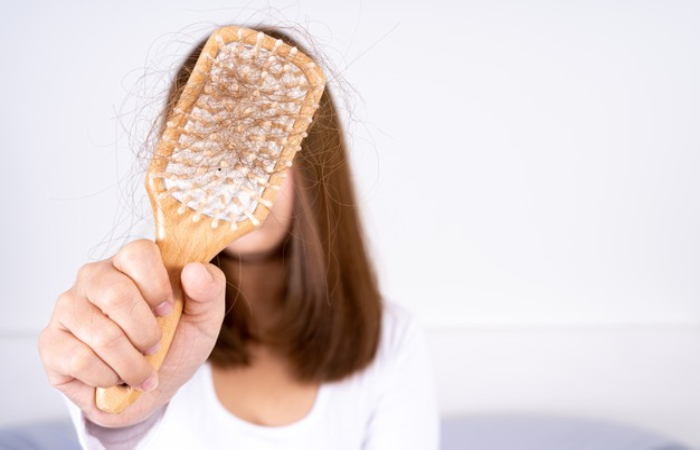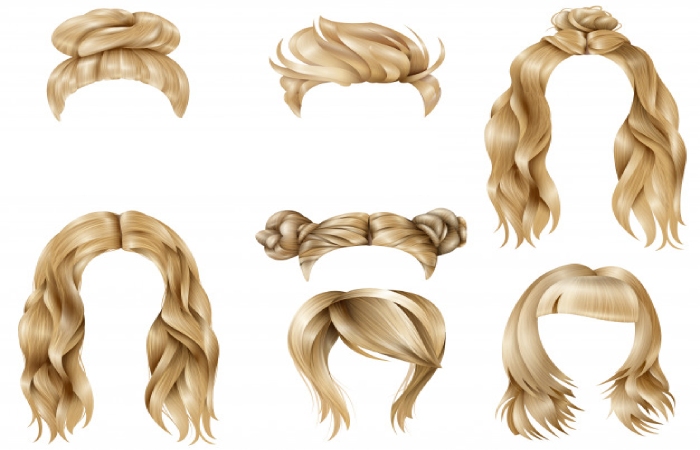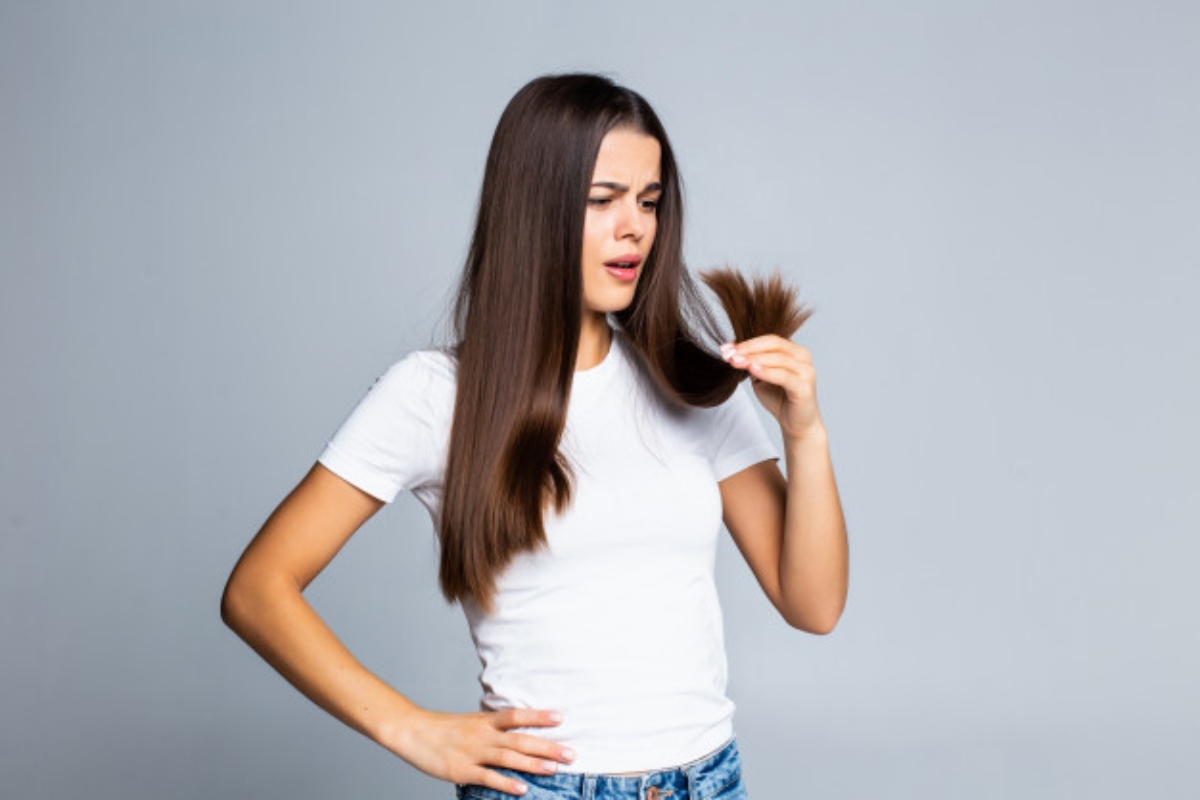There are many causes why women experience hair thinning or loss. Here you will learn more about the causes and the steps you must follow to prevent hair loss and the best cuts and hairstyles to achieve natural volume.
Table of Contents
The Difference Between Thinning and Hair Loss
Before going into the various causes, it is important to distinguish between hair loss and thinning. [Hair loss] occurs when the scalp follicles stop producing new hair and become thinner when the new hair is more fragile and thinner than before. Both lead to less scalp coverage, so hair feels and looks less voluminous. Fine hair is often the precursor to hair loss: the follicle weakens and produces very fine hair fibres until production sometimes stops completely.
The third term used to describe hair loss is “hair loss.” The scalp usually sheds between 50 and 100 hairs a day. To be considered hair loss, it has to fall out more than this and is generally caused by stress. Many people notice excessive loss due to the large amount of hair left on the pillow after sleeping.
Hair Loss and Thinning in Women: The Causes

[Hair loss] in women sometimes causes stress and low self-esteem but is generally not as excessive as in men when they are bald. Although baldness is a disease in women, other causes lead to thinning and hair loss, such as extreme heating tools, stress, hormones, environmental factors, some medications, and vitamin deficiencies.
Alopecia in Women: FPHL
Female pattern hair loss (FPHL) is described as the condition that most often leads to hair loss in adult women. Its occurrence increases with age, and the disease shows an inconsistent response to treatment. FPHL is not, as previously thought, the same as male pattern alopecia (MPA), also known as baldness.
It is caused by “the progressive miniaturization of the hair follicles and the consequent reduction in the number of hairs, especially in the central, frontal and parietal regions of the scalp.” FPHL can occur at any age and can see severe cases from puberty. Recently there has been an increase in hair loss in women between the ages of 25 and 40 and a second wave of cases during menopause between the ages of 50 and 60. Links made between baldness and female genetics, hormones, and even environmental factors.
Hormones and Hair Loss in Women
Harvard Medical School states that “approximately one-third of women will experience hair loss (alopecia) at some point in their lives. In postmenopausal women, up to two-thirds experience thinning or baldness. Hormonal changes, especially menopause, can often lead to hair loss as estrogen and progesterone production decreases and androgens increase. This androgen, a male hormone, is believed to shrink hair follicles, causing hair loss and eventually hair loss.
Hair Loss in Women Caused by Excess Styling
If you have noticed that your hair is thinning or falling out more, that does not entirely mean that it is due to FPHL. Over-styled scalps, especially those of African American women, have been shown to have severely damaged hair follicles.
Scientifically known as traction alopecia, the combination of scalp tension, heat, and chemicals can lead to gradual hair loss caused by damage to the hair follicle from prolonged or repeated exposure to the hair follicle.
The hairstyles that cause the most damage with regular use are braids, dreadlocks, and extensions (especially chemically treated hair). Once the follicle is damaged, it can no longer produce healthy hair so that women may experience weaker and stunted hair growth in the damaged areas.
Can Stress Cause Hair Thinning in Women?
The short answer is yes, and there is even a scientific name for it: “Telogenic Effluvium. This term, known in 1961, refers to excessive hair loss due to stress and claims that it is one of the most common causes of hair loss. Hair loss begins 3-4 months after a stressful event but generally does not result in complete baldness (up to 50%) and lasts no more than six months. Cases that persist beyond these 6 months are classified as “chronic telogen effluvium.” Once the hair begins to grow, it can take 12-18 months for significant growth to occur.
If you have noticed sudden [hair loss], it is important to see a professional for a diagnosis. Since hair loss occurs a few months after the stressful event, patients often fail to connect to hair loss. Stress triggers aren’t necessarily immediately obvious – they can range from poor diet to poor sleep to weight loss.
While there is no technique to prevent the body from responding to a stress trigger, research suggests that counselling is considered the best and safest treatment.
Environmental Factors Related to Hair Loss
Two main environmental factors have been linked to hair loss and thinning in women: diet and pollution.
Symptoms related to scalp contamination include itchy scalp, dandruff, oily scalp, and pain. High levels of dirt cause particles like dust and smoke to settle on the scalp and then penetrate the skin and hair follicles. This increases oxidative stress in the follicle cells and leads to further hair loss. The itchy sensation caused by pollutants on the scalp can also lead to excessive scratching, damaging the skin and leading to further hair loss.
When it comes to hair problems caused by pollution, studies have shown positive hair results when antioxidants, mild shampoos, coconut oil, and hair serum are used regularly. However, more exploration is needed on the long-term effects of pollution on skin and hair.
Medications that can Cause Hair Thinning
Medications associated with [hair loss] include acne medications, antibiotics, blood thinners, antifungals, immunosuppressants, cholesterol-lowering drugs, and some antidepressants. As with any prescription medication, it is important not to stop treatment prematurely, even if you suspect it is causing hair loss. It is best to communicate with a professional about possible alternatives.
Scar tissue can also be why the hair does not grow back in some scalp regions because it does not have the glands necessary to produce oil.
Hairstyles for Fine Hair

While many of the causes of thinning and hair loss do not yet have scientifically proven solutions, certain styles and colours create the impression that hair is more voluminous. Here are our six favourites:
Strategic Reflections
Highlights can instantly make your hair appear much more voluminous. With lighter colours on the outside and darker hues underneath, it increases brightness and a sense of depth. The best person to advise you on shades and how to use them is a professional colourist. As for makeup artists, you are ready to learn how to get the most out of your hair.
Low Collected
When the hair falls on the forehead, it shows how fine it is. So throw all your hair back into a low (but not too tight) bun or ponytail. A high bun/ponytail draws too much attention to your hair rather than a low hairstyle. A little bit of hairspray will ensure that your hairstyle lasts. A colour that flatters your skin tone will also make your hair look thicker and healthier.
Wet Effect Look
The wet look is not only reserved for models at Fashion Week, but it can also be a great option for people with fine hair. Since the hair sticks to the scalp with the help of a wet-effect gel, the areas where hair has been lost are hidden. Do not use a comb when applying the gel as the teeth will expose the scalp. Instead, use your fingers. Leaves hair dry from medium to ends so that it does not look greasy.
Forks
Another way to hide areas with less hair is to use bobby pins to cover the area with another strand of hair. This is a handy trick for hairless areas or areas where the hair has been thinned due to over-styling. If the accessory attracts attention, it will attract all eyes, and no one will notice the thickness of the hair.
Short Look to the Side
Fine hair? A dark tint combined with a quick look can make it appear thicker. Another option is to shave one side as it creates more hair on the other side. If you don’t dare with this look, pull your hair to the side. Apply a spray to add shine and dimension.
Discreet Carding
I don’t think it’s your typical XXL carding. Our recommendation is a super subtle brushing that will make your hair look much fuller. First, you need to dry your hair. Next, take a section of hair from the crown about 2cm thick and use a comb to comb the strand from the top to the roots. Repeat this process with another strand. The more hair you comb, the greater the effect. Lastly, straighten the front strands and gather all of your hair into a low ponytail.
An appointment with a professional doctor and then a stylist is the best way to diagnose the causes of thinning or hair loss and find the most appropriate colours and styles. The most important thing is to know that this problem affects not only you but millions of women around the world.






